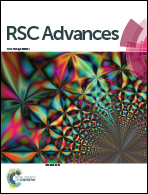Effect of chloride ions on the corrosion behavior of carbon steel in an iron bacteria system
Abstract
Reclaimed water used as circulating cooling water can effectively relieve water stress, but the corrosion problem in it is very prominent. In particular, Cl− and iron bacteria (IB) are important influencing factors of corrosion behavior in a circulating water environment, and both of them often coexist in circulating water systems, so it is crucial to study their synergistic effects. This paper investigated the effect of Cl− on the corrosion behavior of carbon steel in the IB system by use of weight loss measurements, electro-chemistry and X-ray photoelectron spectroscopy (XPS). In the first 1–9 days of the experiment, the increase of Cl− concentration led to an increase of corrosion rate and a decrease of anode potential and charge transfer resistance at the interface. The corrosion rate of the 4ClIB condition reached 0.45 mm a−1 in the 1st day, which was 1.47 and 1.15 times that of 3ClIB and 1ClIB, and its anode potential was 22.6% and 33.8% lower than that of 3ClIB and 1ClIB. This indicates that a higher concentration of Cl− made the anodic reaction easier and the corrosion more severe. However, after 9 days, a decline in the corrosion rate was recorded at similarly high Cl− concentrations. On the 15th day, the corrosion rates for 3ClIB and 4ClIB were 7.0% and 15.6% lower compared to the 1ClIB condition. At this stage, the anode potential and film resistance had increased significantly, to become the dominant factors controlling the corrosion reaction. On the 15th day, the βa values of 1ClIB, 3ClIB and 4ClIB were 1.2, 1.5 and 1.7 times higher than those of the 1st day, and the highest Rb value of 1592.1 Ω cm2 was obtained for the 4ClIB condition, which was 1.9 times higher than that of Rct. In the early stage of corrosion, the surface of the carbon steel was enriched in Cl− due to their high concentration, and the Cl− could easily destroy the developing corrosion product film and promote the generation of Fe2+. At the same early stage, the growth of IB was enhanced, and the metabolism of IB was promoting local corrosion. However, in the later stage of corrosion, biofilms had an increasing effect on corrosion. A high concentration of Cl− accelerated biofilm growth and densified the corrosion product layer which subsequently hindered the anodic reaction and thus inhibited corrosion.



 Please wait while we load your content...
Please wait while we load your content...